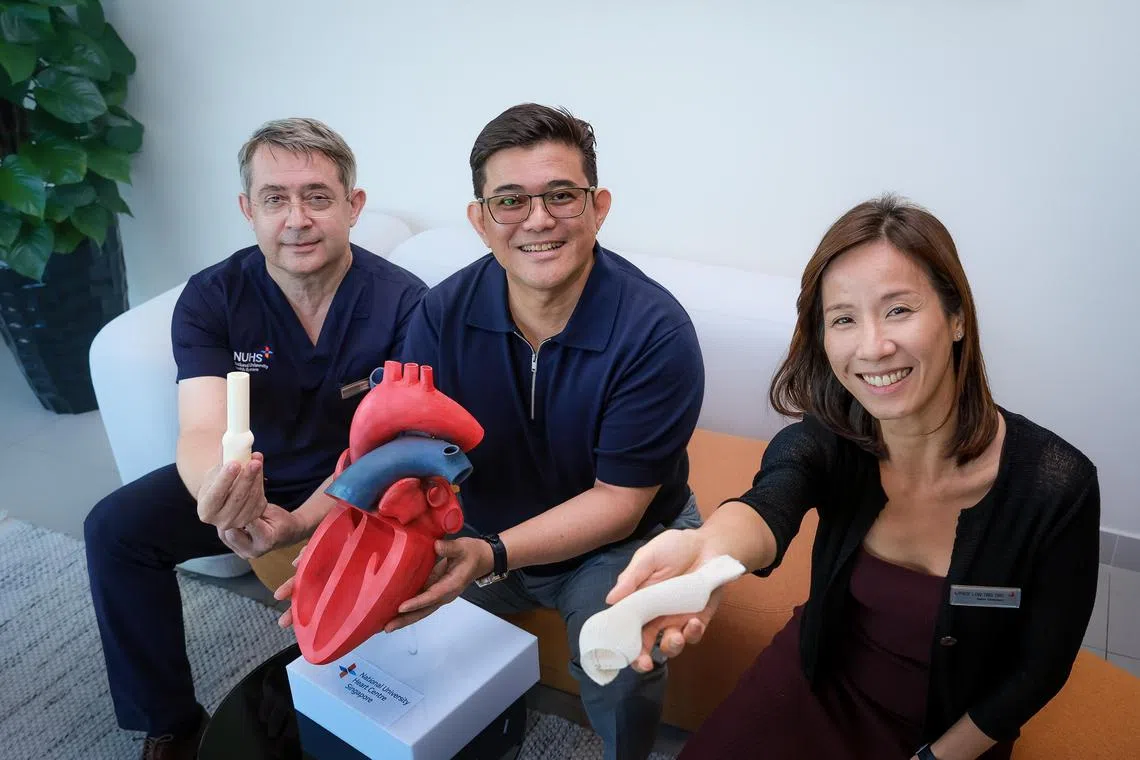Innovative customised procedure now available in S’pore can help prevent aortic aneurysms
Sign up now: Get ST's newsletters delivered to your inbox

Adjunct Associate Professor Vitaly A. Sorokin (far left) and Adjunct Associate Professor Low Ting Ting, with Mr Long Foo Pieng, who was among the first few patients in Singapore to undergo the Pears procedure.
ST PHOTO: GAVIN FOO
Follow topic:
- Aortic rupture has an 80 per cent mortality rate. The National University Heart Centre, Singapore now offers a surgical procedure that can help prevent it.
- If done early, the procedure, which uses a custom-made mesh "glove" to reinforce a weakened aorta, can significantly reduce the risk of a rupture.
- One patient, diagnosed with a congenital heart defect, underwent the procedure and resumed his normal day-to-day activities within six months.
AI generated
SINGAPORE - Aortic aneurysms – where the aorta, the largest artery in the human body, swells to more than 1½ times its normal size – are estimated to result in up to 200,000 deaths worldwide annually.
In cases of aortic rupture, when all the layers of the aorta wall tear, there is an 80 per cent mortality rate.
An innovative surgical procedure, now available in Singapore, can stop an aneurysm from growing and prevent an aortic rupture from happening.
Originating from the heart’s left ventricle, the aorta is the body’s main artery, directing oxygenated blood from the heart to the rest of the body.
An aortic aneurysm can be caused by many factors, such as high blood pressure, genetic conditions or aortic valve issues.
The condition is often under-diagnosed, thus increasing the risk that the bulge in the aorta continues to grow and eventually ruptures along the elastic wall, resulting in rapid, life-threatening blood loss.
To reduce the risk of such an occurrence, the National University Heart Centre, Singapore (NUHCS) has introduced a procedure called personalised external aortic root support (Pears), which uses a custom-made, open-mesh support sleeve to reinforce a weakened aorta.
When applied at the earlier stages of an aneurysm before the aorta has grown too large, Pears acts as a protective “glove” around the artery, preventing further expansion and significantly reducing the risk of a rupture.
“The open-mesh sleeve used to support the weakened aorta in Pears is custom-shaped to a 3D-printed model of a patient’s aorta from their CT scan,” said Adjunct Associate Professor Vitaly A. Sorokin, who heads the adult cardiac surgery division at NUHCS’ cardiac, thoracic and vascular surgery department.
“Due to the customised nature of this sleeve, it provides personalised long-term structural support to the heart vessel, which is crucial in stopping the aneurysm from growing larger.”
Pears was developed by British medical manufacturing firm Exstent, whose founder, Mr Tal Golesworthy, has Marfan syndrome – a genetic disorder that affects the body’s connective tissue and can weaken the aorta’s walls.
An engineer by training, Mr Golesworthy designed Pears as a solution to treat his own aorta, becoming the first person to have the device implanted in 2004.
Though the procedure has been around for more than two decades, it has become more widely adopted internationally only over the past 10 years amid advancements in CT scanning and 3D printing, said Prof Sorokin.
NUHCS is believed to be the first centre to introduce Pears in South-east Asia, first performing the procedure in November 2024.
Six patients, aged between 40 and 55, have undergone the procedure since it was introduced. All of them are faring well.
Among the first few patients to undergo the procedure was 56-year-old Long Foo Pieng, who in 2004 was diagnosed with a congenital bicuspid aortic valve – a heart defect present at birth where the aortic valve has only two leaflets instead of three.
This can result in aortic stenosis, where the valve narrows, or aortic regurgitation, where the blood flows backwards from the aorta into the left ventricle.
These conditions can be fatal if they are severe and are left untreated.
Mr Long, a retired company director, initially managed the condition using medication and lifestyle adjustments; however, it eventually led to aortic dilation, requiring surgery.
Mr Long underwent the Ross procedure, where a patient’s aortic valve is replaced with his own pulmonary valve, with the replacement valve reinforced by Pears, said Adjunct Associate Professor Low Ting Ting, who is a senior consultant at NUHCS’ cardiology department.
After undergoing Pears, Mr Long was discharged from the hospital within a week.
He recovered well, and in six months, was able to resume his normal day-to-day activities.
Mr Long said: “I was very happy (to be) back at the golf course again, going to the driving range almost two or three times a week.”


